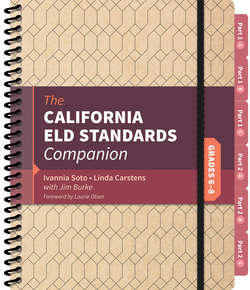Читать книгу The California ELD Standards Companion, Grades 6-8 - Jim Burke - Страница 38
Snapshot 6.1. Summary and Analysis of Stories Designated ELD Connected to ELA in Grade Six
ОглавлениеIn English language arts, students in Ms. Chanthavong’s sixth-grade class summarizeand analyze stories in a variety of ways (e.g., during a teacher-led lesson, during writers’ workshop, with a peer). During the analysis, students focus on the overall structure of stories, how elements such as setting and plot interact, the development and point of view of the characters, and the theme or central idea.
During designated ELD time, Ms. Chanthavong continues to promote summary and analysis of stories by expanding the pool of language resources her ELLs draw upon during their oral discussions and written analyses. She shows her students how, in the different stages of narratives (e.g., exposition, rising action, climax, falling action, and resolution), authors use linking words or transitional phrases to guide readers through the story. She explains how these language resources are also useful for retelling stories, writing original stories, and for writing analyses of stories (i.e., literary criticism). For example, in exposition, adverbial phrases referring to time and place serve to orient the reader to the setting (e.g., in a faraway land, one day in late summer, on the vast plains). In the rising action and climax stages, words and phrases suggesting manner or mood can be used to introduce conflicts or plot twists (e.g., unexpectedly, out of the blue, all of a sudden). In the falling action and resolution stages of narratives, writers can employ words and phrases that suggest conflict resolution and relationships between events (e.g., consequently, ultimately). The teacher supports her students’ understanding of how these words and phrases create cohesion by helping students locate relevant examples of such usage in the texts they read, and subsequently encouraging students to use these strategic language resources in their own writing.
Ms. Chanthavong also helps her students build language resources to summarize and analyze a story’s elements. For example, she builds students’ vocabulary for expressing their ideas and opinions by creating word banks (e.g., synonyms for think might include believe, interpret, propose, come to the conclusion while a word bank for says might include phrases and words like suggests that, indicates, demonstrates). She creates similar word banks for adjectives describing characters (e.g., jealous, courageous, empathetic) or adverbials that indicate time, manner, or place (e.g., throughout the winter, fearlessly, along the coast). The teacher often co-constructs word banks with her students and teaches some vocabulary explicitly (especially general academic vocabulary) so that students can refer back to the word banks as they discuss and compose texts.
During designated ELD, Ms. Chanthavong provides additional structured opportunities for her students to practice using these new language resources so that during ELA they will be able to use the language more confidently when summarizing and analyzing texts.
CA ELD Standards: ELD.PI.6.6b, 8, 10, 12; ELD.PII.6.2b, 3–5
CA CCSS for ELA/Literacy: RL.6.2–4; W.6.3; SL.6.4; L.6.6
The snapshot cited above can be found in its entirety at https://www.cde.ca.gov/ci/rl/cf/, ELA/ELD Framework, p. 550.
